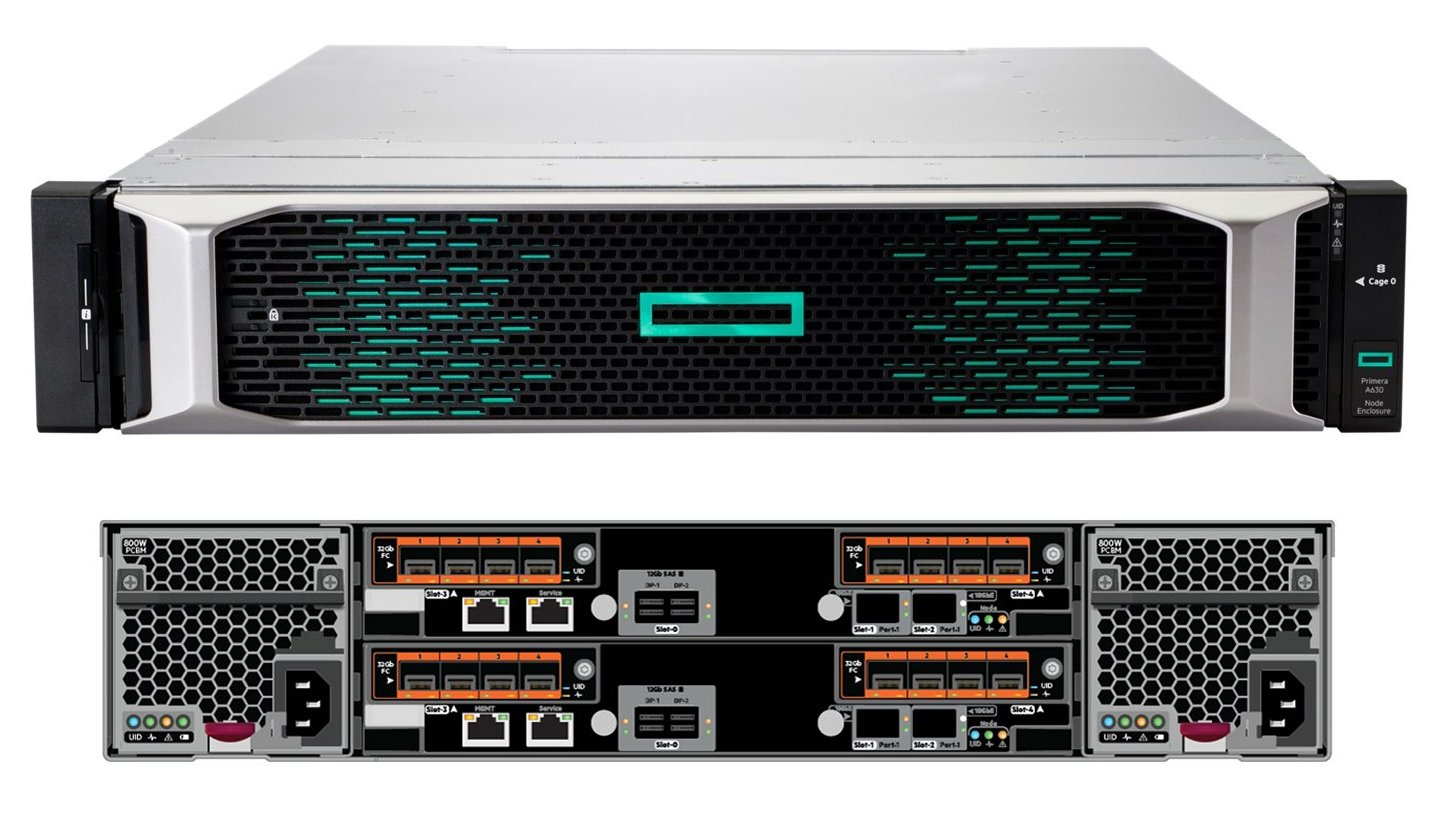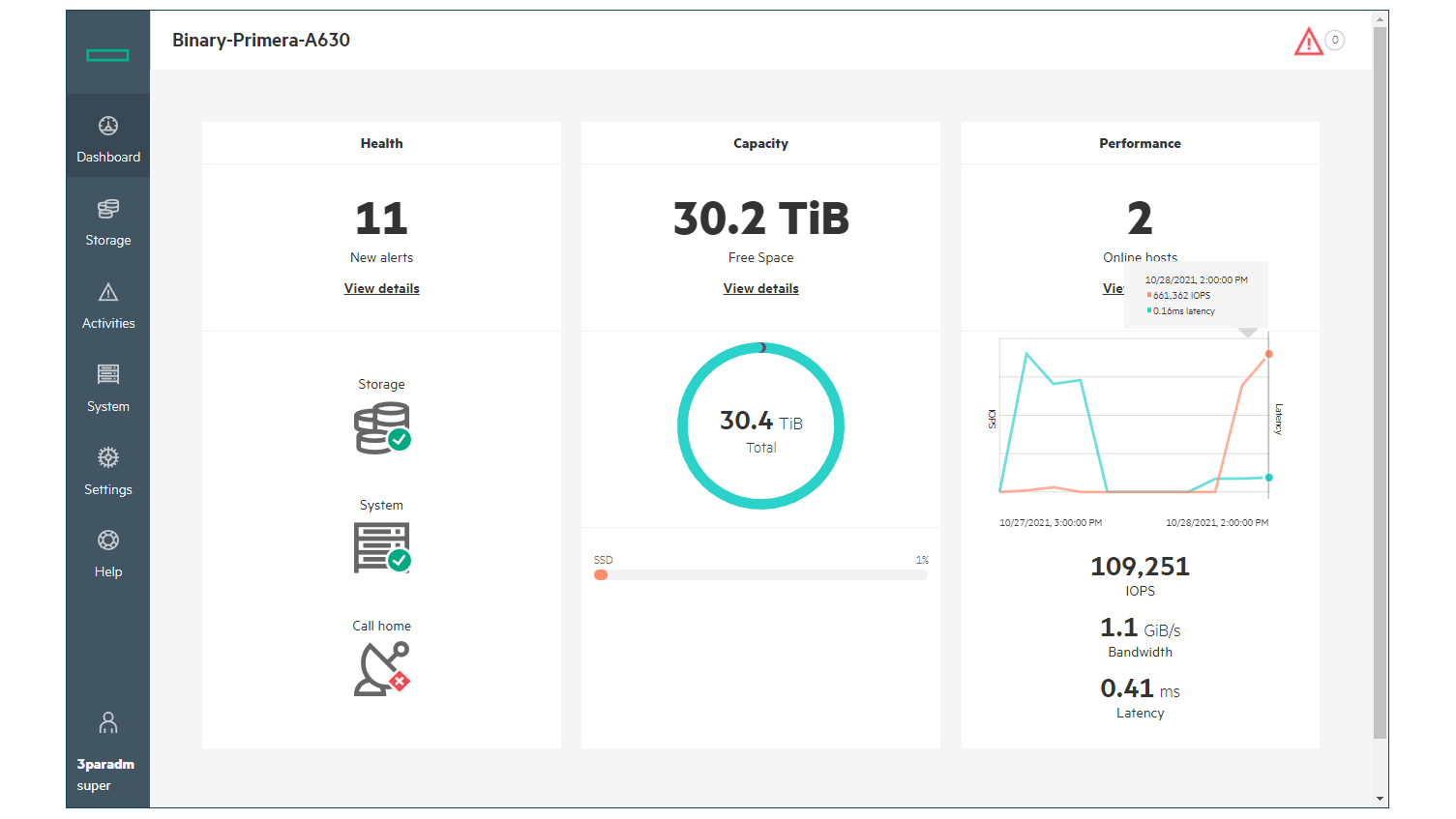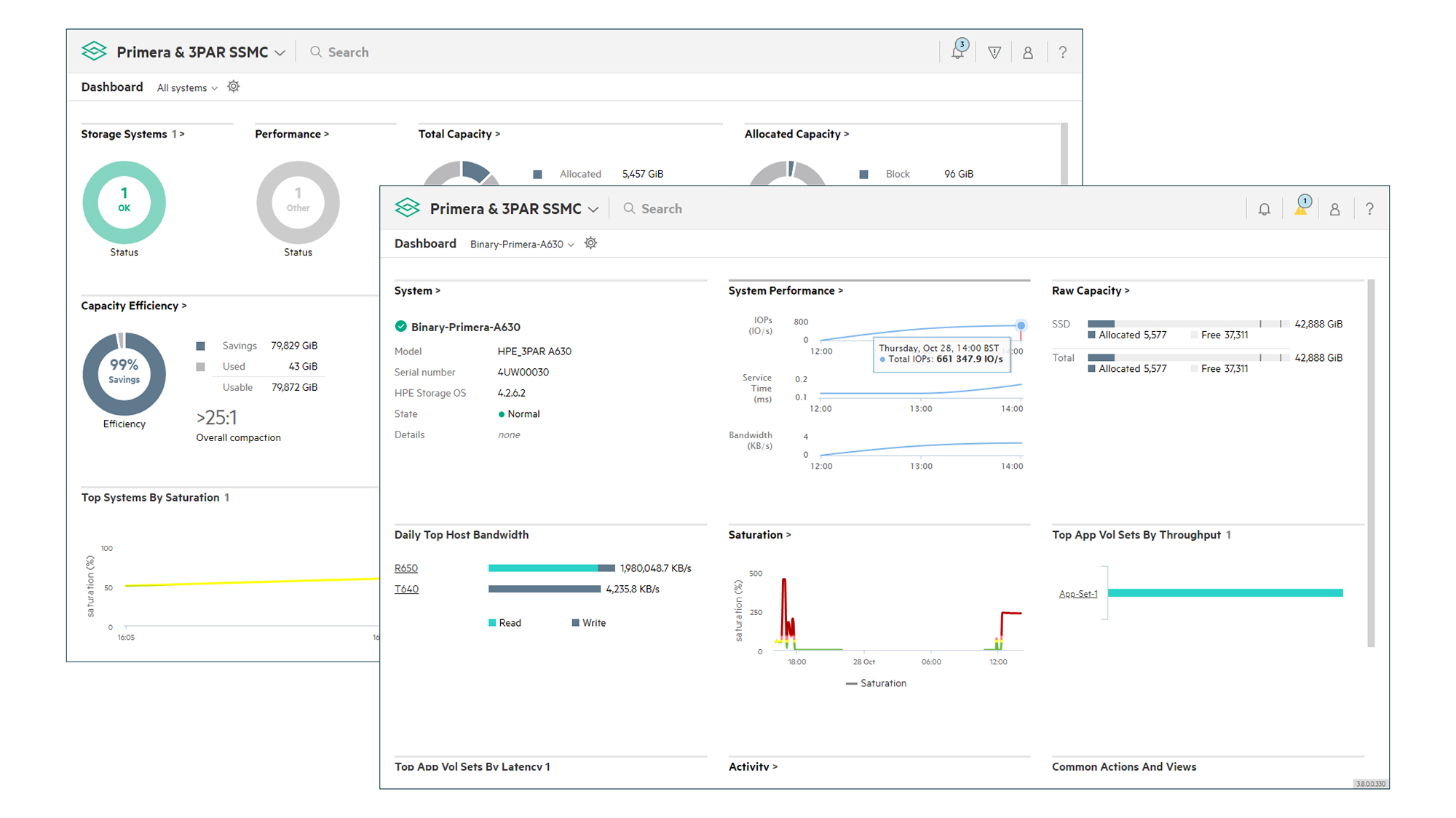HPE Primera A630 review: 100% storage uptime with no excuses
A powerful all-Flash array that ticks all the right boxes for Tier-0 storage

-
+
Simple deployment
-
+
Extensive management choices
-
+
Good FC performance
-
+
Low latency
-
+
High storage expansion potential
-
+
100% uptime guarantee
-
-
Unresolved HPE InfoSight issues

HPE’s Primera Tier-0 storage arrays are designed for enterprises that simply cannot tolerate any downtime. Whereas many competing products use an active/active controller design, the Primera employs an all-active mesh architecture that has no passive components - allowing each volume to be active on all controllers all of the time.
Central to the controller nodes are HPE’s application-specific integrated circuits (ASICs) which are geared up for NVMe performance. A key feature is the CPUs and ASICs in each node are all interconnected so unlike arrays that have to mirror cache contents across controllers, all node cache memory in a Primera array is presented as a global, fault-tolerant pool. The Primera’s OS also comes into play as its services are implemented independently, which means the array can be upgraded or updated without requiring a reboot.
HPE is so confident in the Primera’s architecture that its Proactive Care support package includes a 100% data availability guarantee. There are some provisos such as ensuring the array is kept fully updated but if an outage is traced directly to Primera, HPE will provide a credit of up to 20% of the original purchase price towards future Primera purchases or upgrades.
HPE Primera A630 review: Hardware line-up
In this hands-on review, we’re testing HPE’s entry-level Primera A630 all-flash array. This 2U model employs dual, hot-plug controllers each with 128GB of cache memory, a network management port and dual embedded 10GbE SFP+ ports specifically for HPE’s remote copy over IP (RCIP) replication service.
Port options look good: the controllers have two PCI-E expansion slots and we were supplied with a quad-port 16/32Gbps fibre channel (FC) HBA in each one. A maximum of 16 ports can be installed and HPE also offers quad-port 10/25GbE and 10Gbase-T HBAs.
The array presents 24 hot-swap SSF bays at the front and our system came with a full house of 1.92TB SAS3 SSDs. The last 8 bays are dual-function and can support NVMe SSDs while the SAS3 expansion ports on each controller allow up to 5 enclosures to be added for a total of 144 SSDs.
HPE Primera A630 review: Deployment
Initial deployment is swift: we used HPE’s discovery tool to find the array and after logging in to the Primera OS web console, followed the quick start wizard and had it ready for action in 20 minutes. You don’t need to worry about choosing a RAID type as the Primera automatically divides each physical drive (PD) into 1GB ‘chunklets’ and implements RAID6 across them all.

With our 1.92TB SAS3 SSDs costing nearly seven grand a pop, this has distinct advantages; none are sitting idle and load balancing means their life span is prolonged. HPE has also simplified the process of joining hosts with virtual volumes (VVs) as you place multiple hosts in one set, add VVs to another and bring them all together with an application set.
Using two Xeon Scalable servers running Windows Server 2019, we cabled them to the array over dual 16Gbps FC connections to each controller and could see that our FC MPIO paths were all active and optimised. We then created a host set for both servers, selected their FC paths and added them all to an application set which already had two 5TB VVs ready and waiting.
HPE Primera A630 review: Management
Management options are extensive. Along with the Primera OS console, we added the A630 to the lab’s Hyper-V virtualized HPE SSMC (StoreServ management console) instance. We were presented with an overview of all HPE storage systems and could drill down to the A630 and check on its system status, performance, volumes, capacities, host bandwidth and more.
If you want to use RCIP, you’ll need SSMC as this can’t be configured from the Primera OS console. Furthermore, although you can use the Primera OS to assign snapshot schedules when creating application sets, they can only be managed from SSMC which is also required for creating virtual copy snapshots.
The Primera was easily integrated into the lab’s HPE OneView 6.3 virtualized instance and those with an HPE Greenlake account can remotely manage it from the Data Service Cloud Console. HPE’s InfoSight is the star of the show though, as it applies AI and ML to historical performance data collections to predict future system loads and provide capacity forecasts.
The only problem was, we couldn’t get it to work. Even though the A630 clocked our HPE Passport account organisation, it resolutely refused to register with it and while this resulted in plenty of head-scratching at HPE, no resolution was forthcoming. To be fair, our review system had seen plenty of previous action in customer sites so its configuration may have been messed about with - but it was disappointing that HPE was unable to fix this and reveal all of InfoSight’s glories to us.
HPE Primera A630 review: FC performance
Starting with one server, Iometer reported speeds of 40.4Gbits/sec and 42.4Gbits/sec for sequential reads and writes with random operations returning nearly the same numbers. Throughput was also good, and for sequential operations Iometer recorded 648,300 IOPS and 165,500 IOPS, with random operations returning 653,500 IOPS and 177,600 IOPS.

Adding our second server to the mix returned cumulative sequential reads and writes of 80.8Gbits/sec and 48Gbits/sec while random numbers came to 80.8Gbits/sec and 47.9Gbits/sec. It was the same story for throughput, too; sequential and random reads and writes delivered 802,600 IOPS and 247,500 IOPS and 799,800 IOPS and 273,700 IOPS respectively.
In our throughout tests, we also noted that latency was impressively low, ranging between 0.4ms and 1.5ms. We did find that running our tests on VVs with HPE’s advanced data reduction enabled resulted in reduced write speeds, but this didn’t have any impact on latency.
HPE Primera A630 review: Verdict
HPE’s Primera A630 and its innovative all-active architecture makes it a great choice for delivering Tier-0 storage to business-critical apps. We found it remarkably easy to deploy and although HPE failed to get it talking to our InfoSight account, general management features are very impressive. FC performance is good with the array exhibiting extremely low latency, while HPE’s 100% data availability guarantee will be very reassuring for organisations where downtime is a dirty word.
HPE Primera A630 specifications (as reviewed)
| Chassis | 2U rack |
| Storage bays | 24 x SAS3 SFF hot-swap bays |
| Storage included | 24 x HPE 1.92TB SAS3 SSDs |
| Power | 2 x 800W hot-plug PSUs with cooling fans |
| Controllers | Dual all-active controllers each with the following: |
| CPU | HPE ASIC |
| Memory | 128GB cache |
| Array support | RAID 6 |
| Network | Gigabit management, 2 x 10GbE SFP+ RCIP ports |
| FC host ports | 2 x 4-port 16Gbps Fibre Channel HBAs (max 16 ports) |
| Management | Web browser |
| Expansion | 2 x SAS3 ports (max 5 enclosures) |
| Base warranty | Primera – 3 year parts only, SSDs – 5 years, 3yr HPE Proactive Care |
Get the ITPro daily newsletter
Sign up today and you will receive a free copy of our Future Focus 2025 report - the leading guidance on AI, cybersecurity and other IT challenges as per 700+ senior executives
Dave is an IT consultant and freelance journalist specialising in hands-on reviews of computer networking products covering all market sectors from small businesses to enterprises. Founder of Binary Testing Ltd – the UK’s premier independent network testing laboratory - Dave has over 45 years of experience in the IT industry.
Dave has produced many thousands of in-depth business networking product reviews from his lab which have been reproduced globally. Writing for ITPro and its sister title, PC Pro, he covers all areas of business IT infrastructure, including servers, storage, network security, data protection, cloud, infrastructure and services.
-
 Cleo attack victim list grows as Hertz confirms customer data stolen – and security experts say it won't be the last
Cleo attack victim list grows as Hertz confirms customer data stolen – and security experts say it won't be the lastNews Hertz has confirmed it suffered a data breach as a result of the Cleo zero-day vulnerability in late 2024, with the car rental giant warning that customer data was stolen.
By Ross Kelly Published
-
 Women show more team spirit when it comes to cybersecurity, yet they're still missing out on opportunities
Women show more team spirit when it comes to cybersecurity, yet they're still missing out on opportunitiesNews While they're more likely to believe that responsibility should be shared, women are less likely to get the necessary training
By Emma Woollacott Published
-
 OpenAI wants developers using its new GPT-4.1 models – but how do they compare to Claude and Gemini on coding tasks?
OpenAI wants developers using its new GPT-4.1 models – but how do they compare to Claude and Gemini on coding tasks?News OpenAI says its GPT-4.1 model family offers sizable improvements for coding, but tests show competitors still outperform it in key areas.
By Ross Kelly Published